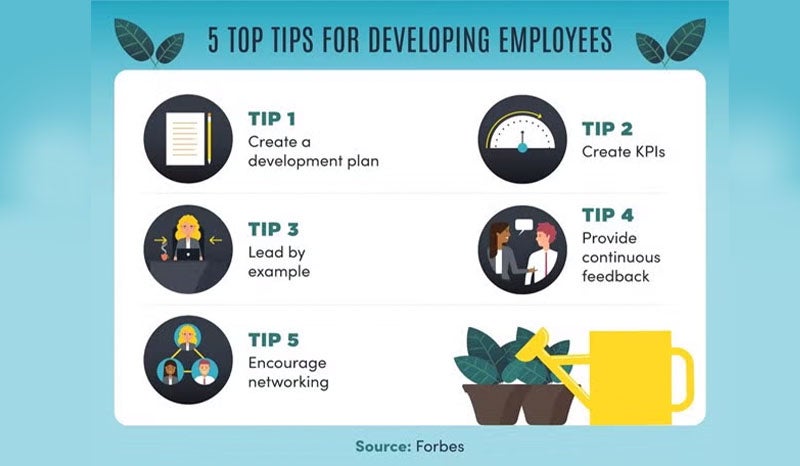Henry Ford, legendary founder of the Ford empire, once said, “The only thing worse than training your employees and having them leave is not training them and having them stay.”
Ford’s famous words have come to represent what all leaders and managers know to be true: The development of employees is critical to organisational success in more ways than one.
In the two centuries since Ford first recognised the importance of employee development, our understanding of why it is so important has significantly evolved. To put it simply, employee development is critical because, if you don’t train your employees, they leave: According to LinkedIn, 93 per cent of all employees will stay longer with a company if they’re offered development opportunities. Beyond this, employees who are offered the opportunity to develop are more engaged in their work, as well as more productive.
In today’s ever-evolving work environment, continuous employee development is essential to employees building the skills sets required to do their job. Put simply, leaders and managers in every business need to recognise that employee development programs are not an option – they are an essential part of leading a successful business.
Employee development tip 1: create a development plan
In business as in life, those who fail to plan, plan to fail. Creating a career development plan for employees is critical, as it provides a road map for what their future might look like, and what actions and activities will be needed to reach certain goals and milestones. However, even if the organisation has a certain definition of success, not everyone will want to achieve the same things, in the same way. Having specific and individualised plans will help employees feel confident that their development goals are being treated as unique and important.
When creating a plan with employees, make sure it is actionable. A great way to create the best possible plan is to ensure that it is a SMART one.
A SMART (Specific, Measurable, Achievable, Realistic, Time-based) plan will enable leaders and employees to track – and meet – development milestones.
A development plan should include short- and long-term career goals. It should include development activities, and who is responsible for doing what. It may also be linked to an employee’s performance and financial compensation; for example, the organisation may specify that if an employee completes certain training in a specified period of time, they may be eligible for a promotion or a bonus.
Employee development plans: additional resources
Employee development tip 2: establish KPIs
A robust development plan is the essential first step in employee development. Yet to bring ultimate clarity to a plan, KPIs (key performance indicators or performance objectives) are required.
In any given plan, KPIs are often set as either certain milestones, for example, complete this training in a certain period of time, or as activities tied to quantitative metrics, for example, if you complete advanced sales training, we will expect you to increase your sales by 15 per cent. Adding quantitative KPIs as a form of development can help employees understand their development milestones, both in the short and long term.
KPIs are important for a number of other reasons as well. They clearly and unambiguously show managers, the organisation and the employee whether or not certain milestones have been achieved. They help align the goals of employee development to broader organisational performance indicators, for example financial indicators. And they help drive accountability, from both an employee and a leadership perspective.
Employee development tip 3: identify opportunities for job enrichment
After setting up the all important foundations of a development plan and KPIs, the next step in developing an employee is engaging in activities that will foster learning opportunities and growth for that employee. One of those activities is job enrichment.
Job enrichment is defined as any activity that can be undertaken by an employee that will stretch, grow and challenge their current capabilities, enabling them to further develop in their role. These types of activities are often focused on improving soft skills, for example leadership and communication skills. Job enrichment can help either broaden someone’s skill base (for example, give them exposure to new skills they may have never used before) or deepen their existing skill base (give them the opportunity to learn how to do something better).
In organisations of all sizes, job enrichment can occur in many ways. For example, to broaden an employee’s understanding of different parts of the organisation, they may join a special working group for a project. They may also join a committee, for example a diversity, equity and inclusion committee, that gives them experience in different issues within a company.
Job enrichment: additional resources
Employee development tip 4: enable job shadowing
Beyond the activities that are possible within their role, employees can also develop in other ways. One of these ways is through what is called job shadowing.
As the name suggests, job shadowing is where an employee “shadows” or works closely with another team member, usually either a person from another department or a more senior person within their own team. Job shadowing can be beneficial for a number of reasons. An employee can gain exposure to a role that is entirely different from theirs, giving them opportunities to broaden their skills. They can learn from more senior and experienced people within their own team. And, if they are interested, they may be able to explore other career opportunities by seeing first-hand how others work.
Typically, job shadowing is a passive development activity, meaning the role of the person shadowing is to observe and learn, as opposed to actively completing work.
Job shadowing: additional resources
Employee development tip 5: provide a job rotation
Another more immersive type of employee development is job rotation. During a job rotation, an employee moves through different roles or functions within an organisation. For example, an employee who works in the information technology (IT) department might rotate to the human resources (HR) department for a period of time. Throughout the rotation, the employee works in their new temporary role as if it is their job. They complete all tasks and activities of that role, have the same KPIs and performance goals as others in that role and may even report to a new manager.
Job rotations can be set for any length of time, but anything from a few months to a year will help employees extract maximum value out of this development opportunity.
Employee development tip 6: mentor or coach your employee
Mentoring and coaching are some of the most well-known forms of employee development for a very good reason: They work. Both mentoring and coaching can help employees develop across technical and soft skills, yet the two approaches vary.
Mentoring is focused on overall employee development. Typically, an employee advises, trains or helps to develop another employee. Mentoring can happen between a senior employee and a junior employee, or on a peer-to-peer basis when one employee has experience in an area of the business in which another employee would like to gain experience. For example, an employee from the IT department might learn from a mentor in the customer service department.
Mentoring can be formal, with an established structure and set goals created for the purposes of development, or it can be informal, in which case it may simply be a casual arrangement where the senior and junior employees periodically meet.
Coaching is a different form of employee development as it focuses on the development of specific skills and the improved performance that results from that skill development. For example, under a coaching arrangement, an employee may be given sales training with the expectation that their sales performance will improve.
Employee development tip 7: lead by example
When leaders consider how to develop their employees, they typically think of the tasks involved, for example, organising training and development for a particular skill, or arranging for a mentor or coach. Rarely do they think of their own behaviour as a significant development tool – yet it is one of the most powerful employee development tools at their disposal.
A significant influence on how an employee behaves in the workplace – and their attitude toward various elements of their role and the organisation – are shaped by their manager. When a manager is negative or critical of professional development, an employee is likely to doubt the process. Conversely, when a manager makes substantial additional effort to grow, learn and develop, an employee is more likely to follow suit and want to invest in their own growth.
By role-modelling continual professional development, managers can help build credibility in the development process and foster trust among employees that development activities are worthwhile. In addition, when a manager is a champion of development, a culture of continual improvement is built in the organisation, and development is seen as an ongoing process.
Leading by example: additional resources
Employee development tip 8: provide continuous feedback
Employee development is not a one-way street. Rather, it is a process of helping an employee continually refine their skills. In order to do so, employees need to receive regular feedback.
Contrary to the practices that still exist in many organisations today, regular feedback is much more than appraising an employee at their annual performance review. If feedback is only given once per year, an employee only has a single opportunity to refine the way they work.When feedback is given more routinely, employees are able to learn and improve continually.
Providing feedback can be challenging, and managers need to ensure they are providing constructive feedback, as opposed to criticism. A manager telling an employee what they have done wrong is considered criticism, whereas constructive feedback focuses on what an employee could do better in the future.
Providing continuous feedback: additional resources
Employee development tip 9: be honest and open about barriers
Employee development is associated with many benefits, including increasing employee engagement and retention. For this reason, when development can’t happen, employees and leaders alike may be frustrated. In this situation, the best thing for leaders to do is to be open and honest about barriers to development, and try to remove them where they can.
For large organisations especially, some development tools such as job rotations can be challenging to organise. This is because job roles can be quite niche, and learning the ropes can take some time. Many other barriers to development may exist as well, including budget constraints, time constraints and the ability of an employee to participate in development activities when their own responsibilities are extremely demanding.
It is important for leaders to be honest about these barriers and do as much as possible to break them down to support the development of their employees.
Transparent leadership: additional resources
Employee development tip 10: encourage networking
Career success often depends on not just what you know but whom you know as well. For this reason, networking is a great way to encourage employee development. Networking helps employees gain exposure to industry professionals, processes, situations, jobs and workplaces that they may have otherwise never experienced.
Managers can help their employees develop their network in many ways. The first is directly within their organisation. When a manager makes the effort to introduce an employee to their peers, team members from different departments and the leadership team, an employee automatically gains access to a broader network. Ideally, these introductions should happen when an employee first joins a team, but the process of developing a network should be ongoing.
Beyond that, managers should encourage their employees to join professional organisations, attend networking events and workshops and join online networking sites such as LinkedIn.
Employee development tip 11: invest to get a real return
Employee development of any kind is not free: Either it costs the business money directly, or it costs time invested that could otherwise be spent doing the employee’s core responsibilities. But leaders need to remember that employee development is an investment, and that organisations should expect to see a significant return on that investment over time.
For example, if a manager invests heavily in a mentoring program for team members, they may not see the return straight away. But over time, those employees will develop skills that add value to the organisation
When selecting employee development activities, managers need to be cognizant of the fact that months may be needed for the benefits of those activities to show.
Employee development ROI: additional resource
Employee development: an essential investment for the future
For managers and leaders busy with their own roles, employee development can sometimes feel like yet another task to be completed. But for the organisation, and for the employees themselves, professional development is much more than that. It is an opportunity for employees to set exciting goals for their future and to work toward them in a productive and fulfilling way. Ultimately, employee development is an essential investment in the success of an organisation.
To discover why Deakin is ranked as one of Australia’s top universities for student satisfaction and to find out more about what our online postgraduate courses have to offer, contact us on 1300 034 524.





